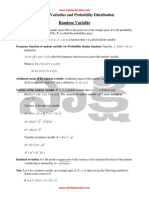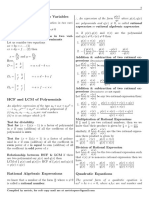Solution Set 2
Solution Set 2
Uploaded by
TomicaTomicatomicaCopyright:
Available Formats
Solution Set 2
Solution Set 2
Uploaded by
TomicaTomicatomicaOriginal Description:
Copyright
Available Formats
Share this document
Did you find this document useful?
Is this content inappropriate?
Copyright:
Available Formats
Solution Set 2
Solution Set 2
Uploaded by
TomicaTomicatomicaCopyright:
Available Formats
763312A QUANTUM MECHANICS I - solution set 2 - autumn 2012
1. On The Probability Density
The wave function of a particle in one dimension is
(x, t) = xe
2|x|it
.
a) Calculate the probability density.
b) Let us consider intervals of the form [x
1
4
, x +
1
4
], where x R. Determine
the interval in which the particle is most likely found.
c) What is the probability to nd the particle at the range [2, 2]?
Solution
a) The probability density function associated with the position of the particle
is the squared norm of the wave function. This function is usually called just
probability density. If the wave function is square integrable, it must be normal-
ized before calculating the probability density. In order to obtain an expression
for the normalized wave function, we calculate the normalization coecient C.
It is determined by the normalization condition
_
[C(x, t)]
[C(x, t)] dx = 1. (1.1)
We note that this equation determines C up to an arbitrary phase factor. We
choose C to be real. As we then solve for C
2
, we obtain
C
2
=
__
[(x, t)]
[(x, t)] dx
_
1
. (1.2)
On the other hand,
_
[(x, t)]
[(x, t)] dx =
_
x
2
e
4|x|
dx
= 2
_
0
x
2
e
4x
dx
=
1
16
. (1.3)
Therefore
C
2
= 16. (1.4)
The probability density
(x) = [C(x, t)]
[C(x, t)]
= 16x
2
e
4|x|
. (1.5)
1
Figure 1: The probability density (x)
b) Let us assume that we are dealing with a square integrable wave func-
tion (as we are in this problem). Then the probability for nding the particle
within an interval [x
1
, x
2
] is given by
P(x
1
, x
2
) =
_
x2
x1
(x) dx, (1.6)
where (x) is the probability density. Now we can paraphrase our problem by
saying that we are solving for the global maximum points of P(x
1
4
, x +
1
4
).
Let us denote these points by x
i
, i = 1, 2, . We note that they satisfy the
condition
d
dx
_
x+1/4
x1/4
(s) ds
x=xi
= 0. (1.7)
Let us assume that a (x 1/4, x + 1/4) and study the function appearing at
the left-hand side of the previous equation. We obtain
d
dx
x+1/4
x1/4
(s) ds =
d
dx
a
x1/4
(s) ds +
d
dx
x+1/4
a
(s) ds
=
d
dx
x
a+1/4
(s
1
4
) ds +
d
dx
x
x1/4
(s +
1
4
) ds
= (x +
1
4
) (x
1
4
). (1.8)
Now we see that Eq. (1.7) is equivalent with
(x
i
1
4
) = (x
i
+
1
4
). (1.9)
That is, the probability density has equal values at the endpoints of the interval
we are searching for. Moreover, this condition implies that
(x) vanishes at
2
some point within the interval (x
i
1
4
, x
i
+
1
4
). This, in turn, leads us to see
that we are only concerned with intervals containing a maximum point of (x).
To summarize, we know that the interval we are searching for has the following
properties:
1. It contains a maximum point of (x).
2. The probability density (x) has equal values at the endpoints of the
interval.
After one has determined all the intervals having these two properties, one
has to calculate the associated probabilities of nding the particle. Then one
can determine the most probable interval by comparing these probabilities.
Now we have the tools to solve the problem at hand. The derivative
(s) =
_
32se
4s
64s
2
e
4s
, s 0
32se
4s
+ 64s
2
e
4s
, s < 0.
(1.10)
It vanishes at s
1
= 1/2, s
2
= 0 and s
3
= 1/2. We see that s
1
and s
3
are
maximum points. Let us now determine the center point x
1
of the interval
containing point s
1
. We do this by imposing the condition that the probability
density has equal values at the endpoints of the interval:
_
x
1
1
4
_
2
e
4(x11/4)
=
_
x
1
+
1
4
_
2
e
4(x1+1/4)
. (1.11)
Note that we made use of the fact x
1
1
4
< x
1
+
1
4
0. By solving this equation,
we learn that
x
1
=
e + 1
4e 4
0.541. (1.12)
Let us denote by x
3
the center point of the interval containing s
3
. The fact
that the probability distribution is symmetric implies that
x
3
= x
1
0.541. (1.13)
Moreover, it also implies that the particle is found equally likely in either of
these intervals. Based on the theory we constructed earlier, we can say that all
the other intervals have lower probabilities of containing the particle.
3
c) The probability to nd the particle at range [2, 2] is given by
P =
_
2
2
(x) dx
= 16
_
2
2
x
2
e
4|x|
dx
= 32
_
2
0
x
2
e
4x
dx
=
_
1
41
e
8
_
0.986. (1.14)
4
2. On The Probability Current Density
A particle is described by the wave function
(r) =
e
(ika)r
r
; a > 0 constant.
Calculate the probability current density S, when r
2
= x
2
+y
2
+z
2
. How does
S behave for large values of r?
Solution
First we must normalize our wave function. That is to say, we have to determine
such a constant C that
_
R
_
1
C
(r)
_
1
C
(r) dV = 1. (2.1)
We note that this normalization condition determines C up to an arbitrary
phase factor. We choose C to be real. Then
C
2
=
R
3
|(r)|
2
dV
=
2
0
e
2ar
r
2
r
2
sin dr d d
=
0
e
2ar
dr
1
2a
0
sin d
2
2
0
d
2
=
2
a
. (2.2)
Let us now redene (r) so that it becomes normalized. That is to say, let us
dene
(r) =
1
C
e
(ika)r
r
. (2.3)
The probability current density
S =
m
Im(
) . (2.4)
For the sake of simplicity, we carry out the calculation in spherical coordinates.
We obtain
S =
m
1
C
2
Im
e
(ik+a)r
r
r
r
e
(ika)r
r
=
a
2m
Im
e
(ik+a)r
r
(ik a)re
(ika)r
e
(ika)r
r
2
r
=
a
2m
Im
(ik a)re
2ar
e
2ar
r
3
r
=
ak
2m
e
2ar
r
2
r. (2.5)
We easily see that S 0 when r .
5
3. Expectation Values of Momentum and Energy
A particle is described by the wave function
(r, t) =
1
N
e
2br
e
it
; b > 0 constant.
First, calculate the normalization factor N so that
_
R
3
|(r, t)|
2
dV = 1.
Then, calculate the expectation values of momentum and energy.
Solution
The normalization condition
_
R
3
|(r, t)|
2
dV = 1 (3.1)
determines N up to an arbitrary phase factor. We choose N to be real. Then
N
2
=
_
R
3
_
e
2br
e
it
_
_
e
2br
e
it
_
dV
=
_
0
_
0
_
2
0
r
2
sin e
4br
dd dr
= 4
_
0
r
2
e
4br
dr
=
8b
3
. (3.2)
Note that the last equality is obtained through integration by parts.
Let us use spherical coordinates when we calculate the expectation value of
momentum. We obtain
p =
_
R
3
pdV
= i
_
R
3
dV
=
i
N
2
_
R
3
e
2br
r
r
e
2br
dV
= i
2b
N
2
_
R
3
e
4br
r dV. (3.3)
We easily see that the integrand is antisymmetric
1
. Therefore the contributions
from any two opposite points cancel out with each other. Furthermore, we easily
1
Let us say that m and n are positive integers. We call a function f : R
m
R
n
antisym-
metric if f(r) = f(r) for all r.
6
see that the integral converges. Consequently, the integral vanishes. However,
let us also formally calculate this. Writing the volume element explicitly, we
obtain
p = i
2b
N
2
_
0
_
0
_
2
0
r
2
sin e
4br
r dd dr. (3.4)
On the other hand,
r =
i sin cos +
j sin sin +
k cos . (3.5)
As we substitute this into Eq. (3.4), we see that the integrations over the angles
make the integral vanish. Thus
p = 0. (3.6)
The energy expectation value
E =
_
R
3
_
i
t
_
dV
=
i
N
2
_
R
3
e
2br
e
it
(i)e
2br
e
it
dV
=
N
2
_
R
3
e
4br
dV
= . (3.7)
The last equality follows from the fact that the value of the integral appearing
at the second last line is N
2
.
7
4. Free Particle In Three Dimensions
Let us consider a free particle in three dimensions. Show that the divergence of
the probability current density vanishes. That is, show that
S = 0.
What does this result mean?
Solution
The wave function of a free particle in three dimensions is
(r, t) = Ae
i(krt)
. (4.1)
The probability current density
S(r, t) =
m
Im[
] . (4.2)
Now direct calculation yields
= ik. (4.3)
Consequently,
= i|A|
2
k. (4.4)
Since k is a real vector (i.e. its components are real),
Im[
] = |A|
2
k. (4.5)
It follows that
S(r, t) =
|A|
2
m
k. (4.6)
Now we see that the probability current density is a constant with respect to
position. That is, S(r, t) is constant with respect to r. It immediately follows
that
S = 0. (4.7)
In order to give an interpretation for this result, we consider some arbitrarily
chosen region of space. Indeed, Eq. (4.7) means that the probability of nding
the particle from that region does not vary with respect to time [cf. lectures Eq.
(29)].
8
5. Free Particle In One Dimension
By using the separation of variables, solve the one-dimensional free particle
Schrodinger equation. That is, use the separation of variables to solve
2
2m
d
2
dx
2
= i
t
. (i)
Determine the probability density and the probability current density under the
condition that the two arbitrary constants appearing in the solution are real.
In what case the probability density does not depend on position? In general,
if we know that the probability density is time-independent, what can we say
about the probability current density?
Solution
We begin by substituting a trial function (x, t) = (x)(t) into Eq. (i). After
that, we divide both sides of the equation by the same trial function. Then
the left-hand side depends only on x whereas the right-hand depends only on t.
Since the equality has to hold for all x and t, we conclude that both sides have
to be equal to some constant, say E. Setting both sides equal to E yields two
equations, namely
d
2
dx
2
= k
2
; k =
_
2mE
2
, (5.1)
(t) =
iE
(t). (5.2)
Note that k is real because E is, in fact, the kinetic energy of the particle (and
thus nonnegative). Anyway, Eq. (5.1) is a second order homogeneous dierential
equation with constant coecients. We easily obtain its general solution
2
(x) = C
1
e
ikx
+ C
2
e
ikx
. (5.3)
Eq. (5.2) is a rst order homogeneous dierential equation with constant coef-
cients. We easily obtain its general solution
(t) = C
3
e
it
; = E/. (5.4)
Thus the general solution to Eq. (i) is
(x, t) = Ae
i(kxt)
+ Be
i(kx+t)
, (5.5)
where A and B are arbitrary complex constants.
Let us now restrict ourselves to the case A, B R. Then the probability
density
(x, t) =
(x, t)(x, t)
= A
2
+ B
2
+ 2AB cos 2kx. (5.6)
2
Cf. e.g. Fundamentals of Dierential Equations and Boundary Value Problems, Nagle, 2.
edition, section 4.6.
9
Note that we made use of the Eulers formula. We easily see that the probability
density does not depend on position if either A or B is zero. That is, if a particle
is in an eigenstate of momentum, we cannot predict its location at all.
The probability current density (cf. lectures p. 21)
S =
m
Im
_
d
dx
_
. (5.7)
From Eq. (5.5) we obtain
d
dx
= ik
_
Ae
i(kxt)
Be
i(kx+t)
_
. (5.8)
Consequently
d
dx
= ik
_
A
2
B
2
+ 2iAB sin 2kx
_
. (5.9)
As we substitute Eq. (5.9) into Eq. (5.7), we obtain
S =
k
m
_
A
2
B
2
_
. (5.10)
In general, if the probability density is time-independent, the divergence of the
probability current density vanishes [cf. lectures Eq. (31)]. In one-dimensional
case this means that the probability current density is a constant.
10
You might also like
- Quantum Physics III (8.06) Spring 2008 Solution Set 10: ψ (x) = (k/a + i tanh (ax) ) eNo ratings yetQuantum Physics III (8.06) Spring 2008 Solution Set 10: ψ (x) = (k/a + i tanh (ax) ) e7 pages
- OU Open University SM358 2009 Exam SolutionsNo ratings yetOU Open University SM358 2009 Exam Solutions23 pages
- MRRW Bound and Isoperimetric Problems: 6.1 PreliminariesNo ratings yetMRRW Bound and Isoperimetric Problems: 6.1 Preliminaries8 pages
- Cumulative Function N Dimensional Gaussians 12.2013No ratings yetCumulative Function N Dimensional Gaussians 12.20138 pages
- 09 Random Variables and Probability DistributionsNo ratings yet09 Random Variables and Probability Distributions16 pages
- 1 SCHR Odinger's Equation: One-Dimensional, Time-Dependent VersionNo ratings yet1 SCHR Odinger's Equation: One-Dimensional, Time-Dependent Version9 pages
- Fourier Series: 6. Fourier Series: Full, Half and Arbitrary Range Series. Parseval's TheoremNo ratings yetFourier Series: 6. Fourier Series: Full, Half and Arbitrary Range Series. Parseval's Theorem14 pages
- MATH 2300 - Review Problems For Exam 2: Corrected AnswersNo ratings yetMATH 2300 - Review Problems For Exam 2: Corrected Answers8 pages
- Theorist's Toolkit Lecture 9: High Dimensional Geometry (Continued) and VC-dimensionNo ratings yetTheorist's Toolkit Lecture 9: High Dimensional Geometry (Continued) and VC-dimension8 pages
- Rodrigues & Vaz - Subluminal and Superluminal Slution in Vacuum of Maxwell Equations and Massless Dirac Equation 1995No ratings yetRodrigues & Vaz - Subluminal and Superluminal Slution in Vacuum of Maxwell Equations and Massless Dirac Equation 19958 pages
- Some Fixed Point Theorems in Metric and 2-Metric Spaces: S. Venkata Ratnam NaiduNo ratings yetSome Fixed Point Theorems in Metric and 2-Metric Spaces: S. Venkata Ratnam Naidu12 pages
- Non-Linear Dynamics Homework Solutions Week 7: February 23, 2009No ratings yetNon-Linear Dynamics Homework Solutions Week 7: February 23, 20099 pages
- - The Dirac equation, ∂ − m) ψ (x) = 0 ,No ratings yet- The Dirac equation, ∂ − m) ψ (x) = 0 ,8 pages
- The Multivariate Gaussian Distribution: 1 Relationship To Univariate GaussiansNo ratings yetThe Multivariate Gaussian Distribution: 1 Relationship To Univariate Gaussians10 pages
- Solution of Exercise 1: FY8201 / TFY8 Nanoparticle and Polymer Physics INo ratings yetSolution of Exercise 1: FY8201 / TFY8 Nanoparticle and Polymer Physics I3 pages
- Remarks On Chapter 5 in L. Trefethen: Spectral Methods in MATLABNo ratings yetRemarks On Chapter 5 in L. Trefethen: Spectral Methods in MATLAB8 pages
- Applied Mathematics Letters: A. Amini-HarandiNo ratings yetApplied Mathematics Letters: A. Amini-Harandi4 pages
- Practice Quiz 2: Daniel Seleznev March 2014No ratings yetPractice Quiz 2: Daniel Seleznev March 20144 pages
- Chem 373 - Lecture 2: The Born Interpretation of The WavefunctionNo ratings yetChem 373 - Lecture 2: The Born Interpretation of The Wavefunction29 pages
- Linear Equations in Two Variables: Quick Reference, STD: X 1No ratings yetLinear Equations in Two Variables: Quick Reference, STD: X 14 pages
- Mathematics 1St First Order Linear Differential Equations 2Nd Second Order Linear Differential Equations Laplace Fourier Bessel MathematicsFrom EverandMathematics 1St First Order Linear Differential Equations 2Nd Second Order Linear Differential Equations Laplace Fourier Bessel MathematicsNo ratings yet
- Mechanical Properties: Issues To Address..No ratings yetMechanical Properties: Issues To Address..51 pages
- 12th Chemistry EM Centum Special Question Paper English Medium PDF DownloadNo ratings yet12th Chemistry EM Centum Special Question Paper English Medium PDF Download4 pages
- The Different Types of Reboiler Available For Demanding ApplicationsNo ratings yetThe Different Types of Reboiler Available For Demanding Applications8 pages
- Soap: Making Everyday Chemistry Public: Jump To100% (1)Soap: Making Everyday Chemistry Public: Jump To11 pages
- Samb BAB 3 KONSEP MOL DAN PERSAMAAN KIMIANo ratings yetSamb BAB 3 KONSEP MOL DAN PERSAMAAN KIMIA25 pages
- The Key Attributes of Processing Parameters On Semi-Solid Metal Casting An OverviewNo ratings yetThe Key Attributes of Processing Parameters On Semi-Solid Metal Casting An Overview9 pages
- Unit-6 - Physics - Wave Optics (Practice and Solution)No ratings yetUnit-6 - Physics - Wave Optics (Practice and Solution)53 pages
- Quantum Physics III (8.06) Spring 2008 Solution Set 10: ψ (x) = (k/a + i tanh (ax) ) eQuantum Physics III (8.06) Spring 2008 Solution Set 10: ψ (x) = (k/a + i tanh (ax) ) e
- MRRW Bound and Isoperimetric Problems: 6.1 PreliminariesMRRW Bound and Isoperimetric Problems: 6.1 Preliminaries
- Cumulative Function N Dimensional Gaussians 12.2013Cumulative Function N Dimensional Gaussians 12.2013
- 1 SCHR Odinger's Equation: One-Dimensional, Time-Dependent Version1 SCHR Odinger's Equation: One-Dimensional, Time-Dependent Version
- Fourier Series: 6. Fourier Series: Full, Half and Arbitrary Range Series. Parseval's TheoremFourier Series: 6. Fourier Series: Full, Half and Arbitrary Range Series. Parseval's Theorem
- MATH 2300 - Review Problems For Exam 2: Corrected AnswersMATH 2300 - Review Problems For Exam 2: Corrected Answers
- Theorist's Toolkit Lecture 9: High Dimensional Geometry (Continued) and VC-dimensionTheorist's Toolkit Lecture 9: High Dimensional Geometry (Continued) and VC-dimension
- Rodrigues & Vaz - Subluminal and Superluminal Slution in Vacuum of Maxwell Equations and Massless Dirac Equation 1995Rodrigues & Vaz - Subluminal and Superluminal Slution in Vacuum of Maxwell Equations and Massless Dirac Equation 1995
- Some Fixed Point Theorems in Metric and 2-Metric Spaces: S. Venkata Ratnam NaiduSome Fixed Point Theorems in Metric and 2-Metric Spaces: S. Venkata Ratnam Naidu
- Non-Linear Dynamics Homework Solutions Week 7: February 23, 2009Non-Linear Dynamics Homework Solutions Week 7: February 23, 2009
- The Multivariate Gaussian Distribution: 1 Relationship To Univariate GaussiansThe Multivariate Gaussian Distribution: 1 Relationship To Univariate Gaussians
- Solution of Exercise 1: FY8201 / TFY8 Nanoparticle and Polymer Physics ISolution of Exercise 1: FY8201 / TFY8 Nanoparticle and Polymer Physics I
- Remarks On Chapter 5 in L. Trefethen: Spectral Methods in MATLABRemarks On Chapter 5 in L. Trefethen: Spectral Methods in MATLAB
- Chem 373 - Lecture 2: The Born Interpretation of The WavefunctionChem 373 - Lecture 2: The Born Interpretation of The Wavefunction
- Linear Equations in Two Variables: Quick Reference, STD: X 1Linear Equations in Two Variables: Quick Reference, STD: X 1
- A-level Maths Revision: Cheeky Revision ShortcutsFrom EverandA-level Maths Revision: Cheeky Revision Shortcuts
- Mathematics 1St First Order Linear Differential Equations 2Nd Second Order Linear Differential Equations Laplace Fourier Bessel MathematicsFrom EverandMathematics 1St First Order Linear Differential Equations 2Nd Second Order Linear Differential Equations Laplace Fourier Bessel Mathematics
- 12th Chemistry EM Centum Special Question Paper English Medium PDF Download12th Chemistry EM Centum Special Question Paper English Medium PDF Download
- The Different Types of Reboiler Available For Demanding ApplicationsThe Different Types of Reboiler Available For Demanding Applications
- The Key Attributes of Processing Parameters On Semi-Solid Metal Casting An OverviewThe Key Attributes of Processing Parameters On Semi-Solid Metal Casting An Overview
- Unit-6 - Physics - Wave Optics (Practice and Solution)Unit-6 - Physics - Wave Optics (Practice and Solution)

























































































